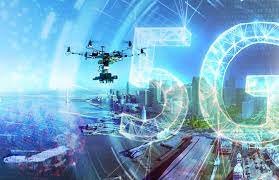I. Introduction
The advent of 5G technology has ushered in a new era of connectivity, offering unprecedented speed and reliability. One of the domains experiencing a profound transformation is the realm of autonomous drones. This article explores the impact of 5G on autonomous drones, unveiling the potential enhancements in performance, capabilities, and applications within various industries.
II. Overview of Autonomous Drones
Autonomous drones, equipped with artificial intelligence and advanced sensors, can operate independently without constant human intervention. They find applications in industries ranging from agriculture and logistics to surveillance and emergency response. The integration of 5G technology promises to revolutionize their functionality and effectiveness.
III. Faster Data Transfer Speeds
One of the most significant impacts of 5G on autonomous drones is the dramatic increase in data transfer speeds. This section explores how 5G, with its gigabit-level speeds, enables drones to transmit and receive data at unprecedented rates. Faster data transfer enhances real-time communication, allowing drones to make split-second decisions and respond rapidly to changing environments.
IV. Low Latency for Real-Time Responsiveness
Low latency is a hallmark of 5G technology, and its impact on autonomous drones is transformative. This section delves into how reduced latency ensures real-time responsiveness. Drones can process information swiftly, making decisions with minimal delay. This is particularly crucial in applications such as surveillance, where timely data analysis is paramount.
V. Enhanced Navigation and Obstacle Avoidance
5G’s impact on navigation is profound, enhancing the precision and reliability of autonomous drones. This section discusses how high-speed connectivity enables drones to access real-time mapping and navigation data. Combined with advanced sensors and AI algorithms, drones can navigate complex environments with improved accuracy and avoid obstacles more effectively.
VI. Extended Range and Flight Time
5G contributes to the extended range and flight time of autonomous drones. This section explores how efficient communication with 5G networks allows drones to operate over longer distances without losing connectivity. Enhanced range and flight time open up new possibilities for applications such as large-scale agricultural monitoring and infrastructure inspections.
VII. Multi-Drone Collaboration
The collaborative potential of multiple drones is amplified by 5G connectivity. This section discusses how 5G enables seamless communication and coordination among multiple drones. In scenarios like search and rescue missions or disaster response, a fleet of autonomous drones can work together efficiently, sharing data and optimizing their collective efforts.
VIII. Edge Computing for Onboard Processing
5G’s impact extends to onboard processing capabilities through edge computing. This section explores how autonomous drones can offload some computing tasks to edge servers connected via 5G. This not only reduces the burden on drone hardware but also enables more complex computations, enhancing the drones’ ability to analyze data in real-time.
IX. Applications Across Industries
The integration of 5G significantly expands the applications of autonomous drones across industries. This section highlights how sectors like agriculture, logistics, construction, and public safety can benefit from the improved performance and capabilities of 5G-enabled autonomous drones. From precision agriculture to rapid delivery services, the potential applications are diverse and far-reaching.
X. Regulatory and Security Considerations
As autonomous drones become more advanced with 5G, regulatory and security considerations come to the forefront. This section discusses the importance of establishing robust regulations to govern the use of autonomous drones. Additionally, it addresses security measures to safeguard 5G-enabled drone networks from potential cyber threats.
XI. Environmental Impact and Sustainability
While exploring the impact of 5G on autonomous drones, it’s crucial to consider environmental aspects. This section examines how increased efficiency in drone operations, facilitated by 5G, can contribute to sustainability efforts. Optimized routes, reduced energy consumption, and precise data collection enhance the environmental footprint of autonomous drone applications.
XII. Challenges and Future Developments
The integration of 5G into autonomous drone technology is not without challenges. This section discusses potential issues such as network congestion, cybersecurity threats, and public concerns. It also explores ongoing research and future developments aimed at addressing these challenges and further enhancing the synergy between 5G and autonomous drones.
XIII. Conclusion
In conclusion, the impact of 5G on autonomous drones is transformative, unlocking new possibilities and capabilities. From faster data transfer speeds to extended range and multi-drone collaboration, the marriage of 5G and autonomous drone technology heralds a future where these unmanned aerial vehicles play an even more integral role in various industries, contributing to efficiency, innovation, and sustainability.
FAQs
- How does 5G impact the data transfer speeds of autonomous drones? 5G dramatically increases the data transfer speeds of autonomous drones, allowing them to transmit and receive data at gigabit-level speeds. This enhancement in speed enables faster communication, facilitating real-time decision-making for autonomous drones.
- What role does low latency play in the responsiveness of autonomous drones? Low latency, a feature of 5G technology, ensures real-time responsiveness for autonomous drones. Reduced delay in data transmission allows drones to process information swiftly and make decisions in real-time, a critical factor in applications such as surveillance and emergency response.
- How does 5G contribute to enhanced navigation and obstacle avoidance for autonomous drones? 5G enhances the navigation capabilities of autonomous drones by providing high-speed connectivity for real-time access to mapping and navigation data. Combined with advanced sensors and AI algorithms, this capability enables drones to navigate complex environments with improved accuracy and avoid obstacles more effectively.
- In what ways does 5G impact the extended range and flight time of autonomous drones? 5G contributes to the extended range and flight time of autonomous drones by enabling efficient communication over longer distances. Enhanced connectivity allows drones to operate in larger areas without losing signal strength, opening up new possibilities for applications such as agricultural monitoring and infrastructure inspections.
- How does 5G facilitate multi-drone collaboration? 5G facilitates multi-drone collaboration by providing seamless communication and coordination among multiple drones. In scenarios like search and rescue missions or disaster response, a fleet of autonomous drones can work together efficiently, sharing data and optimizing their collective efforts with the support of 5G connectivity.

